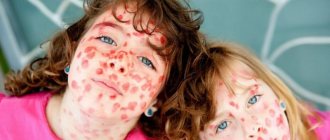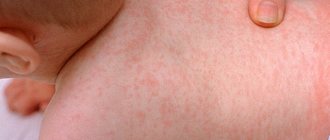Chicken pox or chickenpox is a fairly common disease that can affect anyone. It is mainly diagnosed in children.
The virus spreads easily and quickly and occurs with fever, profuse rashes on the body, and itching. But there are also cases of mild illness in which the child’s body temperature does not rise.
In this regard, many parents are wondering: is chickenpox without fever normal or should we be wary?
Author of the article
Golubeva Lyudmila Alexandrovna
Pediatrician, highest category, 14 years of experience
Does chickenpox occur without fever?
The severity of the infectious process when infected with the chickenpox virus varies among people of different ages.
It is believed that children under one year old, adolescents and adults suffer from the disease seriously. In addition to the rash of blisters with liquid contents throughout the body, their general condition most often worsens. A fever appears in the range of 38-40 degrees, headaches, aches in the bones and large joints occur. Signs of acute respiratory disease are often observed - sore throat, runny nose. Existing chronic illnesses may worsen. A mild form of the disease is often diagnosed in preschool children and primary schoolchildren. They may have chickenpox without fever. This happens if the little person’s body does not suffer from chronic pathologies or disorders in the immune system.
Mild forms of chickenpox are often virtually asymptomatic. Parents may notice 1-2 or several rashes on their child’s body. Even an experienced pediatrician is not always able to identify the cause of the rash at first glance. They acquire their characteristic appearance only when they are completely filled with liquid. Externally, the rash resembles herpes that appears on the lips. No temperature deviations are observed. That is why many mothers turn to doctors with the question: will the temperature always rise with chickenpox, and can the child be considered healthy if it remains in the normal range?
A child who does not have a high fever with chickenpox is still sick. And contagious. His brothers and sisters, friends from kindergarten or school, parents (if they have not previously had chickenpox) will definitely get sick. How the disease will manifest itself in those in contact with the virus carrier depends on the individual reaction of the body.
What to do if it doesn’t go astray
There are several reasons why the temperature does not decrease after taking antipyretic drugs. Very often this happens due to parental mistakes, these include:
- Wrong dose. The required dose of ibuprofen is 10 mg per kg, paracetamol 15 mg per kg (in syrup), it should be calculated based on the child’s weight, and not on his age. It is also not worth knowingly underestimating the dose in an attempt to avoid chemo. In this case, the child’s condition will not improve.
- High expectations. A high temperature of 38 degrees should not subside to normal. A decrease can be observed by 1-1.5 degrees, which is normal. It is important that this makes the child feel much lighter.
- Slow absorption. Before use, shake the drug and warm it to body temperature.
- Quick consumption. In some children, a fever that is too high can cause vomiting. If the child vomits within 15 minutes after taking the medicine, then perhaps not all of it remains in the body. To prevent this from happening, you should give the syrup slowly.
- Incorrect dosage form. Not all drugs are absorbed equally; syrups are much faster. Therefore, in the absence of vomiting, it is recommended to use them.
- High temperature in the room or a warmly dressed child. The body in this state has a hard time giving off heat.
If these measures do not help reduce the temperature, you must call an ambulance.
Do not worry if your child has chickenpox accompanied by fever. You need to understand that it is not always worth knocking it down. The child should be provided with optimal conditions (humidity and temperature) so that the fever goes away on its own. If this fails, use Ibuprofen or Paracetamol.
Symptoms and treatment for chickenpox in children:
♦ Category: Children's diseases.
When does chickenpox occur without fever?
After an illness, the immune system produces specific antibodies, and the person who has recovered from the disease becomes resistant to the herpes virus. With a sharp decrease in immunity, re-infection of adults is possible. After contact with the virus, infection is inevitable in people who have not previously had chickenpox and have not been vaccinated.
Does chickenpox occur without fever? Yes, under certain conditions there is no fever. This is common for two forms of chickenpox.
Atypical rudimentary form
This form of the disease develops in people who were administered drugs with IgG and IgG antibodies during the incubation period (10-21 days after contact with the pathogen). The drugs do not sufficiently neutralize the effect of the virus and are not able to completely eliminate the infection. The disease develops atypically.
Causes:
- Immunoglobulins. A course of drug treatment increases the level of antibodies in the body for up to 30 days. Emergency administration of immunoglobulin within 72-96 hours after contact with the virus also works.
- Blood transfusion, erythromass. Administration of blood or blood components from a healthy donor who is immune to the virus.
- Vaccination. Immunity to the virus after vaccination is formed within 6 weeks, but antibodies begin to be produced already on the second day after vaccination. If a person becomes infected within this period of time, the disease is mild.
The rudimentary form of the disease often goes undetected. She is characterized by mild malaise without symptoms of intoxication, possibly dizziness and a slight enlargement of the cervical lymph nodes. These signs are confused with fatigue, lack of sleep and weather conditions.
The rash is mild. The blisters with liquid contents characteristic of the disease are rarely formed, and they are relatively small. Elements of the rash often go through only two stages - spots and papules (induration). Possible itching. Rashes rarely appear on the oral mucosa (no more than 1-2 elements).
Lightweight typical shape
Chickenpox occurs without fever and with the preservation of residual specific immunity - IgG and IgG antibodies. This is typical for people who had an infection in childhood.
The symptoms are similar to rudimentary chickenpox. The temperature may rise to subfebrile levels from 37.1°C to 37.5°C, mainly in the evening.
Briefly about the disease
Chickenpox is caused by the third type of herpes virus (Varicella zoster). More often the disease occurs in children. The primary infection occurs in the form of chickenpox, and when the pathogen is reactivated, signs of herpes zoster are observed. The infection is highly contagious (infectious) and is transmitted by airborne droplets from a sick person to a healthy person. Intrauterine infection is possible. The patient is considered contagious until the fifth day after the appearance of the last papule.
The disease occurs with moderate signs of intoxication and typical maculopapular rashes on the skin and mucous membranes. After the disease, stable immunity is created for life; secondary manifestations of chickenpox occur in exceptional cases.
Children up to two or three months of age almost do not get sick, since during this period passive immunity is present in their body (antibodies to the pathogen received transplacentally from the mother). The infection primarily multiplies in the epithelial layer of the mucous membrane of the respiratory tract. Next, the virus penetrates lymphogenously into regional lymph nodes, and then into the bloodstream.
Chickenpox is characterized by a successive phase of the inflammatory process in the epidermis. There is a phenomenon of daily breakouts: the first papules on the first or second day, the last on the third to sixth. With each subsequent addition of sleep, the temperature rises and general health worsens. Most often, the disease occurs in mild or moderate forms. The temperature returns to normal on the third to fifth day, the crusts disappear after one to two weeks.
How to treat mild chickenpox
Even with a mild form of the disease without fever, the patient should receive the necessary treatment. Chickenpox is a highly contagious disease. Susceptibility to the Varicella Zoster virus is 100% in people who have not yet had chickenpox. Therefore, the child must be isolated from people until 5 days have passed since the last ulcer on the skin has crusted over.
Chickenpox therapy should be prescribed by his attending physician - a pediatrician, taking into account the course of the disease and the medical history of the little patient. Specific medications are usually not used to fight the virus: the body is able to cope with it on its own. But the goal of treatment is to help the immune system, eliminate and prevent the appearance of unpleasant symptoms.
- Bed rest, rest, and long sleep are the main conditions for a quick recovery, regardless of the presence of fever.
- The child should receive plenty of fluids unless there are contraindications from kidney function. The absence of high temperature reduces the severity of intoxication, but the child’s immunity fights the virus, so toxins (products of the breakdown of the virus) are formed in the blood. These toxins can cause nausea and headaches. By increasing diuresis, you can significantly improve your well-being. You can drink weak tea, compotes, fruit drinks, water.
- No special nutrition is required for the patient, but pediatricians recommend completely eliminating spicy, salty, pickled foods, solid foods (crackers, nuts), and soda.
- Drugs may be used for treatment. If there is no temperature, antipyretics are not used, but you can take headache medications if necessary, antihistamines for itchy skin.
An essential part of treating chickenpox is caring for the skin affected by the rash. In order for the ulcers to heal quickly and not leave marks on the skin, you need to avoid irritating the skin:
- You can put special gloves on your child’s hands;
- bed linen and clothing should be made of soft materials;
- It is recommended to wash with skin rashes, but after the crusts have dried, you can wash the body without using a washcloth.
You can speed up the healing of the rash by treating its elements point by point using:
Symptoms and forms of chickenpox
In this case, chickenpox goes away easily, the child does not experience complications and does not leave scars on the skin. After suffering from the disease, the patient has a strong immunity to the pathogen for life.
Thus, chickenpox without fever often occurs in young children. Proper treatment and care will allow you to quickly cope with the disease, minimizing the risk of complications.
Chickenpox is caused by the varicella-zoster virus. This infection enters the human body through airborne droplets. The contagiousness of chickenpox is very high - 90-100%. Both children and adults suffer from it. Depending on the age of the patient, the state of his immune system, the disease manifests itself as a moderate or significant increase in temperature, signs of general intoxication, and rashes on the body. But chickenpox without fever is by no means uncommon.
How many days does the temperature last
An increase in temperature is a physiological process. An infection enters the body, against which it is necessary to develop antibodies. Depending on how long the temperature lasts, the forms of the disease are distinguished:
- In a mild form, its value does not exceed 37.5 degrees, lasts 2-3 days, and does not require the use of antipyretics.
- Medium shape. Typical for most cases. The temperature rises to 37.5-38.5 degrees, returning to normal on days 5-6.
- Severe form. It is characterized by a high temperature of up to 40 degrees, which can be stable throughout the entire duration of the disease. Rarely occurs in children.
If the temperature does not decrease for more than 5 days, the body is considered to be in a state of chickenpox fever.
Will immunity to chickenpox develop if there was no fever?
Immunity is the body’s ability to protect itself from a previous infection.
Usually, after an illness is brought in, immunity is formed, no matter in what form. At the same time, the virus is in no hurry to leave the body, the infection becomes latent
The main thing is that the pathogens do not come to life at the moment of a strong decline in the immune system and the manifestation of chronic diseases.
To make sure you have immunity against this virus, you can take a blood test; if nothing shows up, you can then get vaccinated.
If you suspect an infectious disease, even in the absence of a high fever or other serious symptoms, you should consult a doctor. A specialist will identify the disease and recommend the correct treatment. After all, the lack of certain knowledge in this area can only do harm, and parents will only make things worse. For example, you should not treat the rash with iodine, which can lead to additional itching. The disease occurs in different forms, but it is believed that if you get sick in childhood, you can survive it without much discomfort. Even if chickenpox is mild, a child can develop immunity.
How to diagnose chickenpox
This disease is diagnosed by clinical picture. To determine the diagnosis, it is sufficient to determine the nature of the rash. Pediatricians take a complete medical history when diagnosing chickenpox in a child. They ask different questions:
- is anyone else in the family sick?
- how long do other family members have contact with the sick child;
- whether your parents had chickenpox;
- does the patient have vomiting and drowsiness?
Next, the doctor examines the sick baby. During an external examination, the doctor excludes diseases such as:
- vesicular rickettsiosis;
- ulcers and ulcers;
- bites of various insects;
- shingles.
In very extreme and controversial situations, laboratory tests are prescribed.
Additional studies may be needed for severe and atypical forms of the disease.
What kind of rash does a baby have with chickenpox?
Reddish spots appear all over the child’s body and are difficult to distinguish from common insect bites. Then the rash quickly spreads to other parts of the body and after a while it covers the legs, arms, face and scalp. The rash also changes its appearance: the red spot swells and fills with liquid. After 8-10 hours, the bubble will burst, and this process is accompanied by severe itching. The burst bubble will dry out and its surface will be covered with a crust, but new pimples will rapidly appear on the body. And they also undergo a similar cycle. If you look closely at the affected areas of the body, you will notice all stages of the rash at the same time, and each subsequent stage is accompanied by a rise in temperature. There may be several hundred blisters on the body, which can even spread to the genitals, oral mucosa, and eyes. If the case of the disease is severe, then blisters may even appear on the palms and soles.
The rash lasts from 4 to 8 days, and then the recovery stage begins. After about a week, the yellowish-brown crusts that formed in place of the blisters begin to fall off, and not a trace of them remains on the skin. But this is possible if the mother closely monitored her child, not allowing him to scratch the wounds and tear off the hated scabs that cause discomfort. If the mother did not notice, and the child tore off the scab, then an infection may enter the wound and this may lead to the appearance of a “pockmark,” and this mark will remain with the person for life. When the last bubble appears on the baby’s body, you need to count five days - now the child does not pose a danger to others and is not a source of infection. Now you can walk with him outside on the playground, and this is not dangerous for others, despite the fact that he will have many dried wounds on his body from burst blisters.
Is it possible to have no temperature?
The course of chickenpox in children aged 2-7 years is most often represented by a mild form. And with such chickenpox, the body temperature may indeed not increase. You can tell that a child has chickenpox by looking at the rash that is traditional for this infection. It is first represented by small spots, which very quickly enlarge, becoming papules, and then watery single-chamber vesicles.
Soon such blisters dry out, becoming crusty, and new spots may appear nearby, which also turn into a blistering rash. The crusty rashes heal completely within 1-2 weeks and, if the child did not scratch them and did not introduce bacteria into the wounds, they do not leave any traces behind.
The first elements of a chickenpox rash appear on the skin of the torso, and then the mother can detect them on the extremities (except for the feet and palms) and on the head. With a mild course, the rash is not widespread and can be represented by only one “wave”, that is, the rash appears on the first day of the disease, and new blisters do not form the next day.
Separately, it should be noted that the chickenpox rash is very itchy and itchy. This causes discomfort to the child and causes whims and poor sleep.
Is reinfection possible?
During the normal course of the disease, antibodies are produced in the blood and re-infection is no longer possible. However, according to medical statistics, about 3% of patients who have had chickenpox get sick a second time. Due to the fact that the chickenpox virus remains in the body forever after illness, secondary infection is possible with a sharp decrease in immunity.
A relapse is also possible when the first time chickenpox passed in a mild, sluggish form. In this case, upon contact with a carrier of the virus, the body does not produce the required amount of antibodies. In adults, secondary infection can manifest itself in the form of herpes zoster.
Its difference from chickenpox is the presence of local foci of rash. In addition to itching, the patient feels pain in the areas where the rash accumulates, which can last from 3 weeks to several months. Shingles usually goes away even without medication.
How is chickenpox transmitted?
The causative agent of chickenpox, which is a herpes virus, is transmitted from sick children by airborne droplets to those children and adults who do not have immunity to chickenpox. Susceptibility to such a virus is very high (reaches 90%), and the pathogen itself is very volatile (can be carried tens of meters), so anyone who spends at least 5-15 minutes near a sick person is at risk of contracting chickenpox.
A child with chickenpox becomes contagious during the incubation period (on the last day).
Next, it secretes the pathogen throughout the acute period, while the rash appears, and also for some time after the formation of the last vesicles on the skin (5 days). The first signs of the disease appear 7-21 days after contact with the source of the virus. On average, chickenpox can begin two weeks after infection.
In most cases, a child who has recovered from the disease acquires stable immunity to chickenpox, that is, he no longer suffers from such an infection for the rest of his life. Recurrence of the disease is extremely rare and is usually caused by immunodeficiency conditions. However, the virus that causes chickenpox does not leave the body after recovery, but remains in the tissues of the nervous system. In old age, it can provoke a disease called herpes zoster.
Therapeutic measures
Chickenpox with a mild course - without the formation of bubbles, has no specific therapy. Doctors advise following the following recommendations.
- Constantly care for and monitor the patient. Make sure that he does not tear apart the formed blisters (if any), as this is fraught with the addition of a secondary infection.
- Even if chickenpox is not accompanied by fever, the appearance of pimples or a small number of them, children should be in home quarantine, since there is no guarantee that they will not infect others. Despite the asymptomatic course of the pathology, the baby is a potential carrier of the disease. The duration of quarantine is two to three weeks.
- It is necessary to change the patient's diet. You will have to stop eating sweets, soda, salty, smoked and fried foods for a while. You cannot be sure that the powder elements did not appear in the mouth. Food should be soft, preferably liquid.
- Sick children should sleep in pajamas made of natural fabric, preferably cotton.
- Single bulk elements, if any, should be treated with brilliant green (1% solution).
- You can only bathe your baby in the shower. You cannot use a washcloth or soap; you need to wait until the last pimple disappears.
If you suspect chickenpox, but there is no main manifestation of the disease - a rash, you should consult a doctor. He will tell you whether you can have chickenpox without a rash and, if necessary, recommend a test for antibodies to the chickenpox virus, which can be done in any laboratory.
Not everyone knows whether chickenpox occurs without a rash, and how the pathology is dangerous for the adult population. The disease is contagious, and its hidden course is a threat to those who have not had it.
In order to prevent the development of complications, vaccination is recommended. This is the only measure that promotes the development of lasting immune defense.
Manifestations of pathology in children and adults vary greatly. One person may have the whole range of symptoms, while another may have only a slight increase in body temperature. The general condition, the severity of symptoms, the presence or absence of eruptive elements depend on the immune system.
How does the disease progress in a mild form?
Chickenpox begins with an incubation period that lasts from 7 to 14 days in children from the moment the infection enters the respiratory tract. Only then do infected children develop symptoms. First of all, skin:
- a rash appears on the skin, usually first on the torso and then on the limbs;
- the rash increases in size and single-chamber formations filled with liquid appear;
- formations burst and are replaced by crusts;
- the scabs heal without leaving a trace unless they are scratched or become infected.
The absence of fever relieves the patient of most of the discomfort associated with intoxication of the body. The child may complain of malaise characteristic of a cold: weakness, drowsiness, lack of appetite. After the blisters burst, the feeling of unwellness usually goes away.
Diet and sleep
As for nutrition, experts do not impose serious restrictions on food during chickenpox treatment. The emphasis should be on dairy and plant foods. It is better not to eat a lot of smoked, spicy, fried, fatty and salty foods when you have chickenpox.
To quickly remove toxins produced by metabolic disorders due to illness, doctors recommend increasing the volume of fluid consumed. You can drink tea, juices, still water, compotes. It is useful to drink decoctions of chamomile, St. John's wort, and calendula. Drinks are taken frequently and in small portions.
For some people, mild chickenpox disturbs peace of mind, causing anxiety and insomnia. A herbal sedative - an infusion of valerian or motherwort - will help improve the condition of the nervous system. Mild sleeping pills are taken when the itching intensifies in the evening and at night and makes it difficult to sleep
When choosing a sleeping pill, it is important to pay attention to possible side effects
Course of the disease
Each new bubble is accompanied by an increase in temperature, because of this the temperature curve for chickenpox has a non-standard appearance. At the peak of the disease, which coincides with the largest number of papules, patients complain of a general deterioration in health, loss of appetite and sleep problems. Small children are capricious and become irritable due to itchy skin. Symptoms of intoxication (one of them is fever) are most pronounced at an early age.
This is how the classic version of the disease proceeds. However, there are cases when some of the described symptoms are absent. In this case, the so-called mild form of the disease occurs.
Erased form of chickenpox
In a child, chickenpox without fever is possible at any age, but more often - from 1 year to 6-7 years or at primary school age. It is during this period that most cases of this infectious disease occur. The erased form of chickenpox usually occurs in children who received specific immunoglobulin after contact with the infection, but before the appearance of the rash.
Immunoglobulin contains ready-made antibodies against the chickenpox virus and helps the body cope with the infection. Sometimes it is not possible to prevent the disease, but it is possible to reduce the severity of symptoms and significantly alleviate the course of the disease. The comparative characteristics of the typical and erased forms are as follows.
Typical form of the disease
Erased form of the disease
In childhood, the temperature often rises only to subfebrile levels, in adolescents - up to 38–38.5 ° C, in adults - up to 39 ° C.
The temperature does not increase or rises slightly for a short time to 37.1–37.3 °C.
In infants, 1–5 days before the rash, lethargy, restlessness, decreased appetite, and often increased bowel movements appear. In older children, these signs are usually more pronounced; in adults, vomiting, severe headache, lumbar pain, and itching of the skin may additionally occur.
The general status of children is not affected; adult patients experience slight weakness and headache.
Skin rashes
Typical rashes appear in parallel with the rise in temperature or several hours later. The rash appears in waves and undergoes changes: pink spots with a diameter of 2 to 4 mm, turn after a few hours into pimples, or nodules, which, in turn, become vesicles, or vesicles. The latter are represented by single-chamber formations surrounded by a red inflammatory rim, and after 1–3 days they dry out with the formation of crusts. The skin is finally cleared of crusts at 2-3 weeks of illness.
There are few rashes. First, small pink spots appear, which quickly transform into papules. The bubbles are underdeveloped, sometimes poorly visible, form in small quantities, and do not last long.
Enanthema (rash on mucous membranes)
Rashes on the oral mucosa, rarely on the conjunctiva, genitals, appear simultaneously with a skin rash. They are a few blisters that break open to form ulcers and heal within 1-2 days.
Rashes do not appear on the mucous membranes, and if they do appear, they exist for a short time and do not ulcerate.
How to lower the temperature?
Most often, for chickenpox, the doctor prescribes antipyretics (antipyretics):
- Paracetamol . It is necessary to consult with your doctor about dosage and contraindications. The drug can be taken in childhood;
- Ibuprofen . Antipyretic and pain reliever;
- Children's Panadol . The medication is available in the form of a suspension, the active substance is paracetamol. Age restrictions: children from 3 months;
- Nurofen syrup.
Antipyretics are available in the form of tablets, suspensions and rectal suppositories (prescribed taking into account the age of the child).
Important!
Aspirin should not be used as an antipyretic in the treatment of chickenpox in children. The drug may cause problems with liver cells. Analgin is a strong remedy and can cause shock (the temperature drops to 34 degrees).
Author: Potapov M.A., associate professor at a medical university in Kyiv
Treatment of chickenpox in adults at home
Treatment of chickenpox at home involves bed rest, adherence to special hygiene standards, taking medications and a specific diet. At the same time, cleanliness and regular ventilation of the room in which the patient is located and his clothes are important.
How to lower the temperature with chickenpox? (medicines, traditional methods for temperature)
If the temperature during chickenpox exceeds the acceptable level, then paracetamol-containing drugs with an analgesic effect are taken (Coldrex, ibuprofen, Nurofen, ibuclin, paracetamol, Panadol). It is strictly forbidden to use products containing acetylsalicylic acid, as they can cause dysfunction of the kidneys, liver and stomach.
The use of folk antipyretic methods is also common, such as:
- drinking plenty of fluids (sudorific teas with raspberries, lemon, currants);
- cool baths with table salt or potassium permanganate;
- wiping with a weak vinegar solution.
Antiviral drugs and antibiotics
For chickenpox, antiviral drugs are also taken, and for severe cases of the disease, antibiotics are taken. The most commonly used drugs include acyclovir, famciclovir, varacyclovir and amixin. Antiviral medications and antibiotics should be used from the onset of the rash for no more than 7-10 days.
Immunocorrection
To maintain and restore the immune system during chickenpox, immunocorrection is used. Basically, immunotherapy drugs are used when chickenpox is severe and with complications, as well as in cases where the patient is susceptible to HIV. The patient is given intravenous immunoglobulins and prescribed drugs containing interferon (Viferon, Cycloferon).
External treatment products
The chickenpox rash is severely itchy. At the same time, scratching the blisters can cause infection to enter the skin.
To reduce the negative effects of rashes, the skin is regularly treated with the following products:
- hydrogen peroxide (3% solution);
- ointments that reduce itching (Psilo-balm, Fenistil-gel, Desitin, Calamine);
- ointments containing an antibiotic (Mupirocin);
- Zelenka or Tsindol (mainly to monitor new rashes).
Diet
Nutrition for infection involves:
- drinking plenty of water;
- small portions;
- 5-6 meals per day;
- if mucous membranes are affected, eat food ground to a paste.
A patient with chickenpox is allowed to eat the following foods:
- vegetables, herbs and non-acidic fruits (increase immunity, improve digestion, saturate the body with essential vitamins and microelements);
- lean fish, chicken and turkey (they are sources of protein and omega-3 fats);
- puree soups, cereal soups and porridge (promote the formation of a film on the affected areas of the oral mucosa and reduce sore throat);
- freshly squeezed juices diluted in a 1:1 ratio with water;
- low-fat dairy and fermented milk products;
- honey;
- bread.
Poultry, fish and vegetables must be boiled, stewed or steamed. It is necessary to exclude from the diet excessively sweet, smoked, flour dishes, alcohol, strong coffee and tea. From liquids, you should give preference to still water, compotes, diluted juices and decoctions of chamomile and rose hips, which will rid the body of toxins.
Folk remedies (2-3 recipes)
Traditional healers suggest using a decoction of chamomile and sage to reduce irritation and disinfect skin with chickenpox. To do this, pour boiling water over the herbs and flowers, leave for several hours, then filter. The resulting infusion is added during daily bathing.
In order to prevent infection and help dry out the rash, use cool baths with a small amount of table salt. Due to its safety, this procedure can be performed every 3-4 hours. In addition, cool water will provide an antipyretic effect.
Among folk remedies, a decoction of chamomile and yarrow is also popular. It will provide long-term relief from itching
It is important to use this composition per water procedure, because over time it loses its healing properties
Vestigial chickenpox in adults
Standard forms of chickenpox exclude the course of the disease without an increase in temperature. So can an adult have chickenpox without fever?
Yes, this is quite possible for a number of specific reasons and, at the same time, there is an absence or scarcity of manifestations of the disease. This form of the disease is called asymptomatic or rudimentary. The reasons are as follows:
- If a person infected with chickenpox has previously undergone treatment with immunoglobulin. The introduction of this drug helps to strengthen the natural protective functions of the body, while replenishing IgG class antibodies in the blood. In addition, the drug contains a huge amount of opsonizing and neutralizing antibodies against various viruses and bacteria;
- If the patient, after contact with the virus, has undergone emergency administration of immunoglobulin within 72-96 hours. This method is intended for people with immunodeficiency and for pregnant women;
- If, after contact with the virus, the person has received emergency vaccination against chickenpox. Administration of a live vaccine containing a live attenuated virus after contact with the wild virus for 72-96 hours helps reduce the risk of complications, reduces the likelihood of developing an infection, or eliminates infection altogether. That is, infection cannot be completely excluded, but thanks to this method, the infection can go away without anyone, including the patient, noticing it;
There is an opinion that another reason for the occurrence of the asymptomatic form of the disease is the individual characteristics of the human immune system. This term means that the body already had antibodies of the IgG and IgG classes during the period of infection. However, this means that the person already has stable immunity, that is, he previously had chickenpox and the recurrence of the disease is almost impossible.
Scientists do not give a definite answer on this score, so if repeated chickenpox is still possible, then it will most likely occur in an asymptomatic form, with a slight increase in temperature and a small number of rashes that a person may not even notice, but a slight and short-term increase in temperature will be attributed to fatigue and “something has gotten colder.” As a rule, with this form of the disease, the temperature is subfebrile, that is, it rises to 37.2 and only in the evening, so it is possible that a slight fever will appear during sleep.
As for itching, it depends solely on the individual characteristics of a person’s skin. Since with rudimentary chickenpox the rashes appear in very small quantities, they may not itch at all, or may cause slight discomfort in the form of minor itching.
Chickenpox without fever and few rashes is an extremely rare occurrence among adults in society.
Note that chickenpox without fever is more typical for children than for adults.
High temperature with chickenpox in a child - normal or pathological
An increase in temperature with the Varicella Zoster virus is a typical symptom of the onset of the disease, often it even precedes the appearance of a rash. This is a natural reaction of the body, activating its defense mechanisms to fight the infectious agent, which, at temperatures below 37 ° C, on the contrary, “feels great”, actively develops and multiplies. But during the period when the temperature rises to 38-39 degrees, the child begins to produce his own interferon, which contributes to the effective fight against pathogenic microorganisms. Taking into account this feature, doctors do not recommend giving children antipyretics if the mark on the thermometer is below 38.5.
Please note that the complete absence of fever with chickenpox is quite normal, indicating a mild (uncomplicated) infection. In severe forms of the disease, a pyretic temperature (39-41 ° C) is observed. This phenomenon is usually short-term, more characteristic of adults than children. However, it also happens that the fever does not subside for more than a week. When does a high temperature occur? This usually happens when a bacterial infection is added to the disease due to constant scratching of the rash.
Treatment and regimen
Mild forms of chickenpox are treated at home. Etiotropic therapy with the main drug against the herpes virus, Acyclovir, is not carried out; in rare cases, it can be prescribed in the form of an ointment according to the doctor’s decision.
During the period of illness, it is important to prevent the addition of a secondary infection. Particular importance is attached to hygiene and treatment of rash elements, which often become “entry gates” for bacteria and viruses
Antiseptics are used to treat the rash:
- 1-2% aqueous solutions of brilliant green, methylene blue;
- 2-3% iodine solution;
- 0.5% solution of potassium permanganate;
- Castellani liquid (Fukortsin).
Treatment is carried out with a sterile cotton swab at least 3 times a day. If the mucous membranes of the mouth are affected, rinse with a 0.1% solution of potassium permanganate. Open wounds and mouth ulcers are lubricated with brilliant green. If the rash is accompanied by itching, wipe the skin with an aqueous solution of 9% vinegar or alcohol (1:3).
Unbearable itching is treated with antihistamines:
- Psilo-balm gel;
- Fenistil gel.
Medicines are applied to skin treated with an antiseptic 2-4 times a day.
For hygiene, disposable or individual items are used, bed linen is changed regularly. Take a short shower every day using soft sponges.
Be sure to drink plenty of fluids, at least 1.5–2 liters of free liquid. Nutrition should be complete with a high content of amino acids and all nutrients. Fried, hot, spicy and smoked foods are excluded.
If you have chickenpox without fever, you can walk outside, but only in deserted places. Fresh air increases lung capacity, stimulates metabolism and blood circulation. As a result, it is easier for the body to cope with the infection. For the same reason, the room is regularly ventilated, letting in fresh air and reducing the infectious load.
3-5 days after the appearance of the last element of the rash, the patient ceases to be infectious. A person who has had mild chickenpox receives full immunity to the virus.
The main danger of asymptomatic chickenpox in an adult is the increased risk of secondary infection. This can be avoided if you adhere to the prescribed treatment and regimen. Don’t waste time wondering if you can have chickenpox without fever
If you feel mildly unwell or have a suspicious rash, it is important to consult a doctor
Chickenpox is dangerous for others, especially for pregnant women who do not have immunity to the virus
At the first suspicion of infection, it is important to reduce contact to a minimum, and if this is not possible, then wear a protective mask.
Post Views: 1,112
Restrictions
If a child is infected with chickenpox and the disease occurs without fever, it is still necessary to take some precautions:
- It is important to organize a quarantine for the baby, that is, provide him with an isolated room (if possible) and separate dishes. It is necessary to change bed linen as often as possible.
- Visiting school, kindergarten and other public places during the period of illness is strictly prohibited, since chickenpox is a very contagious disease.
- As for the bath, it is not recommended to take a shower during this period, but at the same time there is no strict prohibition. Each case is individual, so it is better to consult with your pediatrician about this.
Chickenpox without fever occurs in young children. It is not a dangerous disease and, if the above measures are followed, it passes easily and without complications.
source











